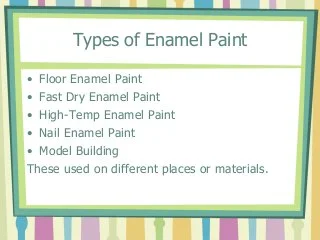Acrylic Paint vs Enamel paint
Will you be painting or repainting your house? Any area in your home may be drastically transformed with a new coat of paint. There are several types of home paint available on the market. among many popular ones these seems to be trending among buyers that’s why we have come up with Acrylic Paint vs Enamel paint differences shared below.
On walls, furniture, and other indoor and outdoor surfaces, acrylic and enamel paints can be applied. Your choice of paint type has not yet been made.
One of the most often requested topics is which paints to choose for specific home improvement or creative work. Each kind has benefits and drawbacks that make it ideal for particular uses. The two most popular types of interior paint—acrylic and enamel—might leave you wondering how they vary from one another. Which one should be utilized, in any case?
The main differences between acrylic and enamel paints are their various bases and application methods. Enamel is an oil-based material, whereas acrylic is a water-based material. The nature of your assignment will significantly impact the type of paint you choose because both have pros and disadvantages and are so diverse.
What is Acrylic Paint?
Pigments suspended in an acrylic polymer mixture make up acrylic paint. The most popular paint in the arts and crafts sector is non-toxic and water-based. Acrylic paints are simple to clean since spills can be cleaned with only soap and water and no chemicals. Other paint mediums can be employed, among other things, to thicken it and speed up drying.
This paint dries quicker than enamel paint and is available at a lower cost. Acrylic paint may be used on various surfaces, including canvas, plastic, stone, stamps, linen, glass, and even metal, in addition to paper and wood. On certain surfaces, such as metal, acrylic paint may be applied directly without any preliminary preparation. However, other surfaces, such as wood may require surface treatment.

In addition, the paint is resistant to the effects of UV radiation, which allows it to work well even when exposed to direct sunlight. Because of this, it is suitable for use on exterior walls. Acrylic paint, on the other hand, is not water-resistant. While some types of paint are less effective in damp environments than others, the vast majority of paint compositions are resistant to water. To ensure the paint’s longevity, you will almost certainly need to seal it.
In most cases, the use of acrylic paint also necessitates the application of a primer. Depending on the project you are working on, you may need to perform additional surface preparation before applying the acrylic paint. Any object that is exposed to the elements almost certainly needs a primer.
Types of Acrylics
The type of acrylic paint you select will be determined by the project you are working on and the surface to which it will be applied like wood, skin etc. Acrylic paint of professional quality is the most incredible alternative, but it is also the most expensive. Nonetheless, because of the high pigment concentration, it produces gorgeous, long-lasting colours after the artist’s grade comes to the student’s grade. It has a lower pigment content and is often more affordable than the artist grade.
What is Enamel Paint?
This paint with a solvent base dries to a durable coating. The main distinction between acrylic and enamel paint is that the former is water-based, while the latter is oil-based. Enamel paints are an excellent option for all exterior surfaces and may be applied to a wide range of materials, including wood, plastic, metal, copper, and glass. Enamel paint may be often cleaned and is moisture-resistant.
Enamel model paint is utilized because of its long-lasting qualities and vibrant colour options. Mineral spirits may be used to remove enamel model paint quickly, and this paint does not require any priming before application. You may use a roller, a brush, or even a spray gun to apply enamel paints, resulting in a durable and lustrous surface.

Walls within a house, particularly those found in bathrooms and kitchens, are typically painted with enamel since they are durable and easy to clean. Because some enamels can resist moisture, they can be used on surfaces that need to be cleaned often and in humid settings.
But there are several drawbacks to enamelling interior walls. Enamels are typically only offered in a limited number of colours, and with only moderate exposure to light, the paint can gradually become yellow. Enamel also draws attention to imperfections and asymmetry in your walls. Acrylic paint is an excellent option for well-lit spaces since it does not reflect sunlight. are you curious to know about tinting base paint for great enamel colors then read our post for the same.
Types of Enamels
The vast majority of enamel paints on the market are oil-based. Additionally, more recent water-based enamel formulations are available. The drying time is the primary distinction between oil-based and water-based enamels. Water-based enamels usually dry in less than eight hours, whereas oil-based enamel cure periods range from eight to twenty-four hours.

Enamels made of oil have the drawback of producing a solid odor. Thus enough ventilation is needed. Oil-based paint poisoning can occur if enamel paint fumes get into the lungs. On the other hand, water-based enamels are straightforward to clean. Just some soap and water will do. Water-based paints are often believed to be safer to use. They might not be as resilient as oil enamels, though.
Difference between Enamel and Acrylic
Acrylic paint is a fast-drying, water-soluble paint that employs a synthetic resin to bond pigments, whereas enamel paint is an oil-based paint with a glossy and opaque finish. Enamel paint is distinguished by its glossy and opaque finish.

Durability
While acrylic paints’ longevity varies, enamels are typically the more robust choice. This is necessary because unsealed paint brush strokes on the surface risk breaking and peeling. Enamels offer a durable and long-lasting finish. It is both waterproof and rustproof.
These qualities are absent from acrylics. Acrylic paint is popular among model painters because it can be quickly touched up, is simple to clean, and is often found at craft stores. However, enamel modelling paint lasts longer than acrylic.
Color Variations
Since powder pigmentation is added to acrylic paint, more colour options are accessible. The paint’s water basis also adds to its durability. Over time, the enamel might become yellow. Due to their quality, professional-grade acrylics are the most costly alternative.
Because the paint has a higher pigment concentration, the colours are vivid and durable. On the other hand, model paint should be applied with enamel. Enamel model paint is more durable and provides more vivid colours. Furthermore, a primer is not required.
Finish
Enamel paint is glossy, but acrylic paint is matte. Once the acrylic has dried, it may always be painted over with another paint to create a glossy surface. Due to the variety of modifications businesses offer, every paint kind contains exceptions.
Matte, satin and semi-gloss enamel finishes are some of the options available. The paint is mainly responsible for the finish. Applying enamels can be done using a brush, roll, or spray. It’s doubtful that brush strokes will be seen on the paint’s surface. Enamels provide uniform covering. Acrylic paintings exhibit apparent brushstrokes.
Levels of VOCs
The majority of oil-based paints are riskier than water-based equivalents. The amount of volatile organic compounds (VOCs), which are chemicals based on carbon, in enamel paint is very high. VOCs harm both the environment and human health. Enamels emit these hazardous fumes and have a pungent odour, so you must operate in a well-ventilated location.
Additionally, you need to safeguard your work area and properly dispose of used paint. You don’t need to worry as much while using acrylic paints because they often contain fewer volatile organic ingredients and are less harmful. Wearing protective clothing, however, will help you prevent getting your skin and clothes stained.
Safety
When dry, both paints are dangerous, although acrylics are typically safer. You must let the object dry in a well-ventilated area since enamel paint needs a lot of time to cure and has a strong odour. The great majority of acrylic product brands are safe and non-toxic. They don’t always emit a strong odour or necessitate the use of safety equipment.
Adhesion
For some surfaces, acrylic paint has to be primed and sealed. The most obvious example is metal. Additional preparation is required to use this paint for particular applications since the primer must be dry before the paint is applied. Frequently, enamel paint is applied without a primer. A primer may be necessary for specific circumstances to make the paint last longer.
Cost and Availability
Often, acrylics are less expensive than enamel. Acrylics made for artists and students are far less costly than those made for professionals. Craft and hardware stores may carry acrylics. Given their superior paint quality, enamels are more expensive. For painting models, they also come in tiny bottles of pricey paint, although enamels for metal or walls are typically available in gallon-sized quantities that are more affordable.
Cleanliness
Due to their convenience in cleanup, acrylic paints with a water base are used in the arts and crafts sector. Latex paint does not require using solvents or paint thinners to clean your workstation, in contrast to enamel paint. You can clean up any mess with the help of water and soap and its disposal is not hard if done properly. The oil basis of the enamel paint may be appropriately disposed of thanks to solvents or thinners that dissolve it. Enamels can also be removed with mineral spirits, a standard model painting procedure.
Anti-fade UV protection
Since water-based acrylic paint is more resistant to the effects of UV radiation, it may be used to paint the exterior of windows and walls. If the enamel is not primed and sealed, UV protection is significantly reduced. On the other hand, certain industrial enamel paints may give protection from UV rays.
Indoor / Outdoor Use
Both acrylics and enamels are advised for usage both inside and outside. The brand and type of your project will determine how you should use the paint. Despite being able to be used both inside and out, acrylic paints are less durable outdoors than enamels. Water is more easily withstood by enamel paint. Additionally, it makes future painting surface cleaning simpler.
Conclusion
This is not a contest to determine whether acrylic or enamel paints are superior. For various surfaces and purposes, different paints are needed. Long-lasting enamel paint gives surfaces a polished, glossy look. Although drying will take longer, there won’t be any brush marks on the surface.
The environment is negatively impacted by it. Although acrylic paint is less durable than enamel paint, it is less damaging to the environment. It is perfect for outdoor work, comes in various colours and tones, and dries quickly, which might leave brush strokes on the surface. checkout if acrylic paint is permanent or not.

FAQs
-
How can I identify whether the paint is water- or oil-based?
There is an easy way to tell if the paint you wish to refinish is oil-based or water-based. Utilizing a cotton ball or soft cloth and rubbing alcohol, scrape a tiny portion of the surface. The paint is oil-based if it is still intact. Before putting on a fresh coat of paint, the surface that has to be repainted needs to be bonder primed. It is water-based paint if it rubs off the surface after application. In this case, you don’t need to recoat the surface; repaint it with any paint.
-
Can you paint over water-based paint with oil-based paint?
Any paint, even water-based paint, may be covered with oil-based paint. For this reason, it is not required to use a primer. Make sure the surface is dry before washing it with a dry cloth and cleaning solution. Then, oil-based paint can be used. Apply the paint in several thin coats as opposed to one thick one.
-
What Makes Acrylic Paint Different from Enamel Paint?
Compared to enamel paint, which creates a glossier finish, acrylic paint provides a more matte surface. While enamel paint can fade and become yellow over time, acrylic paints maintain their colour. While acrylic paints primarily consist of water, enamel paints also include solvents. For kids room you can use glow in dark paint to add more vibrant designs in your house to spread mirth all around.
-
Can You Use Acrylic Paint Over Enamel Paint?
Since these two kinds of paint don’t mix properly, this is not advised. Enamel paint is put over acrylic, which then starts to peel and flake. You can sand the shiny surface to increase the acrylic paint’s adherence. The best strategy is never to combine these two components and remove any previous paint before repainting.

Being associated with art and craft field since decades as a hobbyist and life long learner has given me an opportunity to learn many new things related to art, craft, paints and pottery which i am trying to share with your guys on this website. I have expertise of being professional painter and potter for the last 20+ years
I have learned mind blowing cool tips and insights which makes me a person with ability to improvise and come up with creative ideas and solutions to make stunning and impeccable art pieces of all types which are adored by people across the globe on this website and other platform.


